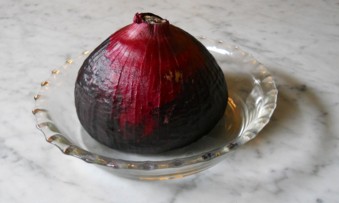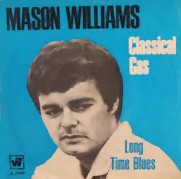|
NOV.
29, 2019 Seventy years ago, my parents and I took up residence in a “Charm Home” that was only six years older than I. The location was atop a hill on a brick-paved road on the outskirts of Cambridge, Ohio. This month's 100 Moons article features vintage photos. |
|
NOV.
26, 2014 When I was a boy, a television program was brought to me by a single sponsor. For example, Dinah Shore’s variety show was sponsored exclusively by Chevrolet, and the closing credits ran over Chevy’s theme song. |
When I was a young man, advertisers realized that not everyone watched Dinah, so it was better to spread their message around to different audiences by buying “spots” in several different programs. But there were rules. For example, no more than one competing car company could buy time in a given show.
Also when I was a young man, CBS decided viewers deserved to be updated about news that broke between Walter Cronkite at 7 pm and their local newscast at 11. The network introduced, right in the middle of prime time, a 30-second headlines update. It was anchored by Connie Chung, as I recall. Almost immediately, however, the local stations claimed this time. At first, like CBS, they used it to inform us about stories that would be covered in more detail at 11. But then they stopped giving us any facts at all. The “newsbriefs” became merely teases — promos to whet our curiosity so we would tune in at 11 to find out what was happening.
Now that I'm an old man, the automotive sector is very competitive, and every car company wants to buy advertising. On a show last night, when the two-minute window for local commercials came along, I first saw the station’s weatherman. “There’s a big storm coming. Will you have to change your Thanksgiving travel plans? Join us at 11 to find out.” And then an announcer said, “This news update is brought to you by Chrysler, imported from Detroit.”
Fair enough. That was immediately followed by a car commercial, which I assumed would be for Chrysler. But no, when they finally got around to identifying the product it turned out to be Infiniti. Then there was a commercial for Chevrolet. And then there was a commercial for Nissan.
Four competing advertisers, back to back! How is a viewer supposed to know which car to buy?
News report: California growers are developing large-scale olive tree farms to undercut Europe’s domination of the oil market.
The story mentioned “extra-virgin olive oil,” a term that's always puzzled me. I tried to reason it out. If virgin olive oil has never “gone all the way,” has extra-virgin oil never even “gone to second base”? What would any of that mean, anyway?
And what would non-virgin oil be? In what way has it been sullied, its virtue defamed? Perhaps it's used cooking oil. The little bits of food have been skimmed off and filtered out, and the oil has been recycled.
Well, I finally decided to look it up. No, non-virgin oil has not been defiled by prior experience in the kitchen. However, I was partly right: it has, in fact, been filtered and refined to artificially reduce extraneous flavors and acidity. But virgin oil is “all-natural,” straight from the fruit. Extra-virgin applies to virgin oil that naturally happens to have less acidity and a better taste. And none of it has even reached first base.
NOV.
23, 2019 ![]() FOCUS ON THE FIELD!
FOCUS ON THE FIELD!
|
The University of Pittsburgh football team was shut out at Virginia Tech yesterday, as I watched on ESPN2. Fortunately I had turned down the sound to listen to the Pitt radio broadcasters, or I might have almost missed the game. The TV producer and director seemed to want to show as little of the action as possible. They preferred to cut away: to rain-soaked fans, to graphics about national standings, but mostly to coaches staring out at the field and occasionally pointing and shouting. A director ought to cut back to the “game camera” at least a few seconds before the ball is snapped, so we can take note of the offensive and defensive formations. However, on several occasions, we didn't return to the action until half a second after the snap. It was hard to tell who had the ball! |
|
I assume the announcers wanted to talk about the coaches instead of the players, so that's whom the director showed us. We saw assistants sitting in the pressbox looking down at their notes and even, for one long stretch, a former coach who was interviewed on camera in the booth while the game proceeded unseen or on a half-screen insert.
A writer for the Pittsburgh Post-Gazette noted, “On Pitt's opening drive of the third quarter, it drove down to Virginia Tech's 29-yard line. There, on a second-and-2, [Kenny] Pickett found V'Lique Carter for a 21-yard gain inside the Hokies' 10 ... but it was negated on a holding call. The penalty was credited to center Jimmy Morrissey, who didn't appear to be involved in the play. There was no replay or explanation from the ESPN crew, though. The announcers instead discussed fishing and the College Football Playoff committee with former Virginia Tech head coach Frank Beamer for 40 seconds in the booth.”
I've always thought we telecasters pay too much attention to the grownups, hoping for an emotional reaction, instead of showing the student-athletes out there on the field. As Teddy Roosevelt reminded us, “It is not the critic who counts; not the man who points out how the strong man stumbles, or where the doer of deeds could have done them better. The credit belongs to the man who is actually in the arena.”
NOV.
22, 2019 ![]() INTERCESSION
INTERCESSION
Why,
it's my Fictional Uninformed Interlocutor!
Hi.
I
haven't seen you lately, Fui. Why so sad?
My
father had surgery last week.
Oh,
I'm sorry to hear that.
Mom
is taking care of him. I'm praying for him; it's the least I
can do.
You're
praying that God will heal him?
That's
right.
That's
called “intercessory” prayer.
I
know. My family goes to church, at least twice a year.
Then
God should already be aware of your Dad's condition.
Of
course He is. God knows everything.
So
why do you need to tell God what He already knows?
Huh?
Well, I'm reminding Him.
He's
forgetful?
And
I'm asking Him to do my family a special favor.
But
I thought you believed God has already laid out a Plan for your life?
Of
course he has.
And
for your father's life?
Of
course.
Do
you dare to think you can prevail upon God to change His
divine Plans?
Of
course.
Even
Jesus prayed, in the Garden of Gethsemane, “Father, not my
will, but thine, be done.”
We're
good Christians. Prayer can work
miracles.
Phooey,
Fui! Prayer doesn't do what you think it does.
Scientists have tested it and found it ineffectual.
Our
family believes in prayer, but we do not
believe in science.
Many,
many experiments have been conducted, and they've produced no
reliable evidence that prayer can cure disease at all!
Our
faith is in the Bible.
Haven't
you read anything else? Of course not, you're Uninformed.
Here, I looked up some facts from the scientific literature.
A double-blind study of 799 coronary surgery patients at the Mayo Clinic in 2001 concluded that “intercessory prayer had no significant effect on medical outcomes.”
Five years later, a meta analysis of 14 controlled studies concluded that “There is no scientifically discernable effect for intercessory prayer.” Those investigators recommended “that further resources not be allocated to this line of research.”
Don't
confuse me with evidence. My mind is made up. Prayer
works! Besides, our pastor told us that Korean women are twice
as likely to conceive after they've been prayed for.
That
particular study was by Columbia University researchers, but it
turned out to be flawed.
It was retracted.
So
are you trying to tell me that praying for Dad won't do any good?
No,
actually that's not at all what I'm saying. It will do
some good, three ways.
|
You see, prayer involves putting your hopes and fears into words.
|
|
NOV.
20, 2019 ![]() CAN YOU STILL HEAR ME?
CAN YOU STILL HEAR ME?
|
Mobile phones have a speaker near the top and a microphone on the bottom, so they can be held like a traditional telephone receiver. But what's the deal with the guy on the right? Josh Fruhlinger tweets, “I see people out in public who are sort of talking into the bottom of their phones but holding the top away from themselves, and the volume of the person on the other end is playing full blast, and I always wonder: why? Who does this?” |
|
He retweets a description of an overheard Presidential phone call. “Holmes says he heard Trump ask Sondland, ‘So, he's gonna do the investigation?’ Sondland wasn't on speakerphone, but held the phone out because it was so loud.” So maybe you move the phone away from you lest its excessive volume blow out your ear.
|
NOV.
18, 2019 |
|
NASCAR teams can regulate the temperature of their engines by controlling how much air comes in through the grille.
During yesterday's championship at Homestead-Miami Speedway, the track cooled off after sundown.
|
|
Denny Hamlin's team reduced the airflow by sticking small pieces of tape over the grille. But that wasn't enough, so they slapped on a big ol' foot-long chunk. |
|
|
My question: why is tape the preferred airflow-modulating method? Couldn't there be adjustable louvers controlled by the driver? |
||
|
NOV.
16, 2019 Thomas Jefferson admired “yeomen,” the small landowners who worked individual farms to feed their families. He considered them ideal American citizens. When I was a college student, I broadcast the feats of a different sort of “Yeomen.” Oberlin's athletes were known as “ye O men.” Recently a costumed student has begun appearing at games to inspire the Yeomen and Yeowomen. Does this new mascot strike fear into the hearts of Oberlin's opponents? Does it depict a Jeffersonian farmer with a spade? No, that would be silly.
|
|
|
NOV.
15, 2019 |
|
While watching Steelers-Browns last night, I put Pittsburgh's local CBS and NBC affiliates on my auxiliary TVs. Both stations devoted the entire last half of their 11:00 PM newscasts to winter weather! Archived scenes of sliding cars and snowplows; interviews about school-closing and runway-clearing procedures; predictions of monthly snow totals; “freezing rain” vs “sleet.” Possible reasons for this highly unusual programming?
|
|
•
Newscasts normally end with sports coverage, but the Steelers game
couldn't be recapped before its conclusion at 11:40. • We had a little snow earlier in the week, leading to the usual panic. Gotta get bread and milk! |
NOV.
13, 2019 ![]() THE IMPORTANCE OF TELEVISION NEWS
THE IMPORTANCE OF TELEVISION NEWS
|
Fifty years ago tonight, Vice President Spiro Agnew spoke to a group of Iowa Republicans. President Richard Nixon's administration, not yet 10 months in office, was fuming at the lack of deference they were receiving from the media — particularly broadcast media, especially following a recent Presidential address. Agnew had been dispatched to launch a counterattack. Because he was representing the executive branch of the Federal government, newsmen felt threatened. His criticisms caused quite a kerfuffle in the broadcast community. This included my Syracuse University graduate class in Television and Radio, which met the very next day. I revisit the incident in a new article titled This Little Group of Men, which was Agnew's description of TV news executives and commentators. |
|
NOV.
11, 2009 ![]() THE
MONSTER OF THE ALLEGHENY
THE
MONSTER OF THE ALLEGHENY
Sunday was a nice day in Pittsburgh, so I drove to the North Shore and took a walk to see some sights.
A helicopter was hovering over the Allegheny River, filming a River Rescue boat for a scene in the new Russell Crowe movie, The Next Three Days. Replicas of the Niña and the Pinta, two ships from the 1492 voyage of Christopher Columbus, were tied up outside Jerome Bettis' Grille 36, where I ate lunch. A few hundred yards downstream, the new Rivers Casino was open. And in between, a pier from the 1915 Manchester Bridge once again has a purpose.
|
|
For nearly four decades, since the structure was replaced by the Fort Duquesne Bridge and demolished in 1970, this abandoned stone eyesore loomed over the riverbank. But now workers have cleaned it up and cut an archway through it. As shown in the artist’s rendering below, it frames a new statue honoring the late host of Mr. Rogers’ Neighborhood. Fred Rogers is depicted twice as large as life. He’s sitting down and tying his shoe, as he did to open each episode of the long-running children’s program he produced at WQED-TV in Pittsburgh. |
|
|
Approaching the memorial from the direction of Heinz Field, as depicted in the drawing, I saw only the back of the figure. Unfortunately, the sculptor was Robert Berks. He prefers a very rough texture, as on his memorials to Albert Einstein and the late Pittsburgh mayor Richard Caliguiri. From the rear, this statue looks like a giant hairy gorilla, slumped on a stump, brooding over the river. |
NOV.
8, 2019 ![]() “CASUAL FRIDAY”? WHAT'S THAT?
“CASUAL FRIDAY”? WHAT'S THAT?
|
|
For about the first 15 years of my career, beginning in 1970, I dressed like a proper professional. I wore a jacket and tie to the office. But then my workplace began to change. I was less often in an office or studio. More often I was working inside a truck, a TV mobile unit where most folks dressed in “work clothes.” The final break came when my salaried position went away with a 1987 corporate bankruptcy. Now a freelancer, I never again had to wear a necktie. (Exception: when traveling on a sports team's plane, ties are generally required for everyone. We can't have star athletes looking like slobs.) |
For more than three decades now, I've dressed casually. I can't imagine what Eric D. Snider has been going through this week.
|
I've never met Eric in person, but I've been following him since 2001. Back then I was preparing to spend a month in Salt Lake City televising the Winter Olympics. I had visited there only once, in 1959, and I wondered what it was like now. I searched online for a local newspaper columnist, and I found the Provo Daily Herald and its humorous “Snide Remarks,” written by Mr. Snider. He was a Brigham Young University graduate whose accomplishments included a song parody celebrating the 1847 migration to Utah. |
|
|
I kept on reading Eric, even after the Olympics were over. By 2005 he had become a freelance movie critic, and he relocated to the considerably more liberal Portland, Oregon. There he partnered with Jeff Bayer for an amusing weekly podcast (left). I think I've listened to all 462 episodes, and their friendly voices have become quite familiar. Eric thought he'd never want to move back to Utah, and “every time I visited I was reminded of why I was glad I no longer lived there.” |
|
However, about four years ago, he began to miss his relatives and Utah friends more than before. He loved “extreme uncling,” as in this photo. |
|
|
Because freelancing could be done from “anywhere that had movies and the internet, and these had both recently come to Utah,” he moved back to Provo in early September. Through the magic of the internet, he and Jeff continued to record their podcast every other week. |
“A few days after I arrived,” he writes, “an old friend reminded me about a full-time writing job that had been posted two weeks earlier. It was the last day applications were being accepted, so I quickly slapped together a résumé and cover letter and applied.”
|
|
Guess what: he got the job! “It's a full-time salary with benefits, such as a grown-up would have.” He started this past Monday, writing content for the Mormon Church — whoops, now they want to be known as the Church of Jesus Christ of Latter-Day Saints — at the CoJCoLDS headquarters in downtown Salt Lake. |
Compared to freelance income, his pay will be significantly greater and more predictable. However, it is an office job that requires a suit and tie. He had to acquire a second suit. And a third one as well.

He now needs to get up much earlier than your typical movie critic in order to catch the 6:48 a.m. FrontRunner. His cat, Dogcat, has to stay home, sadly meowing the Sheena Easton song. Eric asked his Twitter friends about toys for lonely felines. Is there a laser pointer that doesn't require a human to point it?
|
|
|
|
Eric, sporting his three different suits, tweeted these selfies from his first three commutes. “I have immediately identified a problem with wearing a suit on a train,” he reports. “People think you're trustworthy and aren't afraid to sit next to you.”
|
|
|
|
Personally, I don't think I could go back to wearing a suit from nine till five. But Eric seems happy to do so, and after hours he still gets to watch movies and play with his niecephews.
NOV.
5, 2019 ![]() CUTTING REMARKS
CUTTING REMARKS
My mother did most of the cooking in our family. We used to have a big old “butcher knife” that once belonged to my mother's aunt Lizzie Buckingham, who died in 1932. She had carved LB into the wooden handle. But I never learned to wield it properly.
When I moved away from home in 1974, my parents set me up with a set of steak knives. They could be used for paring, but their lightweight 4½” blades limited their potential, and I never became skilled at slicing. However, a couple of years ago in a store, I noticed a nice hefty 6” chef's knife with a manly red handle. That's what you need, I told myself!
|
And across the aisle I saw a German gadget, a V-Prep by Swissmar, that promised to “achieve the perfect slice ... every time.” It's called a mandoline. (That was a new word to me. My computer insists on auto-correcting it into a musical instrument.) |
|
I do like to add a slice of onion to a sandwich. So now I occasionally buy an onion. I cut it in two with the chef's knife and place one half, flat side down, on the mandoline's ramp. The ramp includes a crosswise blade a little above the surface, and sliding the onion down the surface strips off a nice slice each time.
|
|
I used to wrap the remaining half in plastic film to keep the air away from the cut face. Then I realized I could just place it face-down on a 6” glass pie plate until I next crave a slice — two or three days later. |
|
NOV.
2, 2019 I saw a groundbreaking student film project when it aired on CBS-TV in 1968. Dan McLaughlin at UCLA had used a technique now called kinestasis. Three thousand works of art flashed on the screen very briefly, accompanied by instrumental music that became a hit record on its own. |
Film is projected at 24 frames per second. During each second McLaughlin showed us a dozen artworks, each of them for a mere two frames.
|
Television, however, runs at 30 frames per second. Therefore only half of the artworks appeared for two TV frames ( for example, RR) and the other half for three TV frames (for example, SSS). |
|
Twenty years later, I recalled the 1968 project when I learned about the latest thing, digital television. HDTV broadcasts won't fit into the old analog bandwidth without some kind of video compression. I wondered whether the MPEG compression algorithm would be able to handle rapid changes like “3000 Years of Art.” If I understood it correctly, one second of MPEG typically includes only five full-definition “I-frames,” not 30.
|
As explained here, the intervening P-frames and B-frames are reconstructed from their neighboring I-frames. This is accomplished by predicting the motion of objects within the frame. |
|
This algorithm couldn't handle kinestasis, I reasoned. Every second or third frame of the 1968 video (those marked with dots in the first diagram above) was completely different from its predecessor, so it would have to be encoded as an I-frame. Each second would require twelve I-frames (one for each artwork), not just five. To sufficiently compress the data, additional tricks would be required, such as reducing the resolution.
|
|
In the early days of HDTV on my cable TV system, I did notice pixilation (like this extreme example) on live-to-tape programs like Jay Leno's Tonight Show. Immediately after a camera cut, the new angle was blocky for a fraction of a second until the next I-frame came along, at which point it seemed to snap into focus. |
But I guess the engineers have now figured out better methods. The opening title for The Big Bang Theory shuffled through 120 images at an accelerating pace. Even in hi-def, CBS-TV did not explode.
 NOVEMBER
2019
NOVEMBER
2019





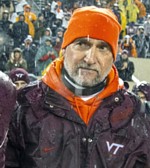
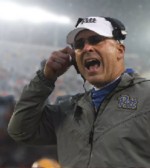
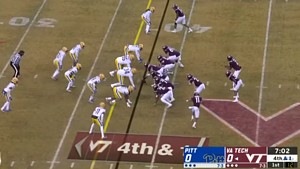











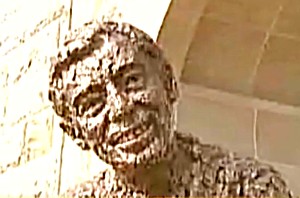







 Monday:
On my way to new employee orientation. Boy will they be surprised
when they find out mine!
Monday:
On my way to new employee orientation. Boy will they be surprised
when they find out mine!



